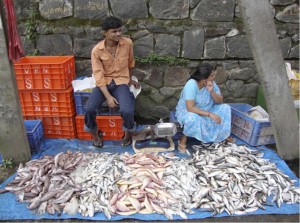STOP PRESS
 Incontrovertible evidence of the wrath of God here in the USA where we have experienced severe tornados and wild weather.
Incontrovertible evidence of the wrath of God here in the USA where we have experienced severe tornados and wild weather.
Now to today’s post, written by quentin cockburn
It has often been said; ‘What has that got to do with the price of fish in India’?
At first I thought it was just an open imponderable. A reflective unanswerable. A paradox within an enigma. A rhetorical flourish. A conversational gap filler, when words, thought and the capacity to argue the toss had all but vanished.
 But then I got to thinking. What is the price of fish in India? Do we really know? And if knowing is important? What bearing should it have on our day to day life?
But then I got to thinking. What is the price of fish in India? Do we really know? And if knowing is important? What bearing should it have on our day to day life?
A great deal, and I’ll tell you why.
Once upon a time we used to have a pretty good grasp of the price of fish. We knew that Flathead was more expensive than Flake. Snapper and Whiting were a little bit more pricey, and the exotics – Crayfish, Bream and Flounder tipped the scales. We knew that the price of Scallops was variable, and, like Mussels and Oysters susceptible to seasonal fluctuations. Now that’s all changed. At the local Coles or Woolworths they’ve recognised, (ahead of the pack you might say) that we can now afford to eat fish imported from Thailand, Vietnam, the Phillipines and Malaysia. Though they may have warnings: “Fish may contain traces of mercury” and you have an inkling that these fish, like Basil Fawltys, “meat substitute”, may contain traces of actual fish, you take it as a “valued client” that the fish on sale from just about anywhere but India is tried and tested.
The local fish may be found less frequently either at Victoria Market, or the local ‘fisho’ in any shopping street. I don’t think anyone worries about the provenance of their fish at the Fish n Chip shop because after it’s been so battered and standardised it may as well be boot.
But the Indians seem to have missed out. I don’t see their fish at Coles and Woollies, and yet I know, from Kevin McCloud and Rick Stein, that they possess a most interesting fishing industry and it all seems to be run by half naked Indians in gaily coloured, roughly crafted wooden vessels. Its the antithesis of what we believe contemporary India is all about as it seems, from the delightful pictures almost completely non standardised. The fish from all those other Asian countries, we assume, are plucked from a fish farm, a tranquil adjunct to a settling pond or treatment plant, where the fish are plumped and primed on human excrement. And why shouldn’t I think that? Cos that’s how they do it over there without our bounty of superphosphate and cheap diesel.
Which gets me back to the price of fish. We are in the fortunate situation that Coles and Woolies are pushing the government hammer and tongs to sign a raft of new free trade deals with our valued overseas clients. I am pleased because of this that the nasty noxious industries we used to have, the orchards round Harcourt, the fruit growers, the vegetable growers, the berry growers and citrus growers are all but doomed. We don’t need them, they’re old industries. The new industries will be all about being managers, (middle managers at the very least) at Centre-link or doing tourism. Play to our natural strengths. With these local industries wiped out it will ensure we get those prices lower and lower, and maintain a level playing field. It’s good for the producer, good for the consumer. And finally when we produce nothing, but have aisles at our supermarkets replete with cheap tomatoes and malaysian fish, we’ll understand what’s meant by the price of fish in India.  And the Indians will then tell us with some authority; ‘We’ll tell you what the price of fish is in our country, (subject to local variations and seasonal fluctuations) just as long as you tell us how long, (precisely) is a piece of string’
And the Indians will then tell us with some authority; ‘We’ll tell you what the price of fish is in our country, (subject to local variations and seasonal fluctuations) just as long as you tell us how long, (precisely) is a piece of string’
It’s that simple.
